Market Size of Indonesia eCommerce Logistics Industry

| Study Period | 2019 - 2029 |
| Base Year For Estimation | 2023 |
| Forecast Data Period | 2024 - 2029 |
| Historical Data Period | 2019 - 2022 |
| CAGR | > 5.00 % |
| Market Concentration | Low |
Major Players
*Disclaimer: Major Players sorted in no particular order |
Indonesia eCommerce Logistics Market Analysis
During the time frame of the forecast, the Indonesia eCommerce logistics market is expected to register a CAGR of more than 5%.
- Indonesia, with its huge population, has great market potential. During the COVID-19 pandemic, e-commerce transactions increased by 23% to a projected USD 32 billion. Total online market sales in Indonesia reached USD 44 billion in 2020, with the e-commerce sector accounting for 72% of the total digital economy value. This increased the demand for eCommerce logistics services, indicating that the market performed very well during COVID-19.
- With a population of 273.5 million people, Indonesia is one of the most promising Southeast Asian e-commerce markets in the world, mainly due to the younger generation's acceptance of online shopping as a more convenient and affordable way to shop. Large and small cross-border e-commerce platforms in the country are also making people more interested in shopping online by offering cashback payments. This is making e-commerce even more popular.Indonesia has the biggest digital economy in the region, making up about 40% of the whole market.It is home to 'unicorns' such as Gojek (ride-hailing), Tokopedia (e-commerce), Bukalapak (e-commerce), and OVO (digital payment), who are resolutely spearheading the country's digitalization. They have attracted investors from all over the world, particularly large tech companies wanting to gain traction in the region. According to Indonesia's Ministry of Communication and Information Technology, about 21 million Indonesian SMBs, or 32% of the total, market their products on online marketplaces. By 2024, the government hopes to get at least 30 million SMBs online. All these factors are contributing to the growth of the market.
- However, in comparison to neighboring countries, internet penetration in Indonesia remains low. While a commercial 5G network has been launched in a few urban areas, many islands and rural areas have limited to no internet access at all. Improving logistics infrastructure continues to be a challenge in a country with approximately 17,000 islands and a vast sea area. The quality of Indonesia's workforce is fundamentally insufficient to meet the demands of its digital industry. Approximately 87% of the workforce has only completed primary and secondary school education. Compared to other Association of Southeast Asian Nations (ASEAN) countries, Indonesia's non-cash payments are still relatively underdeveloped. Another barrier to the development of e-commerce in the country is regulatory uncertainty. While the government has stated its intention to reform, changing certain inward-looking policies will be difficult. Therefore, the regulatory regime is expected to remain unpredictable. These are the challenges that Indonesia needs to overcome to see rapid market growth.
Even though more and more Indonesians are shopping online, most of the country's e-commerce customers are still in the Greater Jakarta area. It is thought that 60-70% of all online shopping in the country takes place in this area. This concentration of e-commerce in Indonesia's big cities has opened up a lot of opportunities outside Greater Jakarta. There are at least 170 million consumers in the second- and third-tier cities who have not been served optimally due to logistical barriers. In order to serve the second- and third-tier cities, several established players in the logistics industry, start-ups, and e-commerce managers are building conjoined warehouse and delivery networks.
Indonesia eCommerce Logistics Industry Segmentation
The term "e-commerce logistics" refers to the transportation, warehousing, and distribution services provided to an online retailer by the logistics company. The Indonesia eCommerce Logistics Market is segmented by service (transportation, warehousing and inventory management, and value-added services), by business (B2B and B2C), by destination (domestic and international/cross-border), and by product (fashion and apparel, consumer electronics, home appliances, furniture, beauty and personal care products, and other products). The report offers market sizes and forecasts in value (USD billion) for all the above segments.
| By Service | |
| Transportation | |
| Warehousing and Inventory Management | |
| Value added services (Labeling, Packaging) |
| By Business | |
| B2B | |
| B2C |
| By Destination | |
| Domestic | |
| International/Cross-border |
| By Product | |
| Fashion and Apparel | |
| Consumer Electronics | |
| Home Appliances | |
| Furniture | |
| Beauty and Personal care products | |
| Other products (Toys, Food Products, etc.) |
Indonesia eCommerce Logistics Market Size Summary
The Indonesian eCommerce logistics market is poised for significant growth, driven by the country's large and youthful population embracing online shopping. The market has shown resilience and expansion, particularly during the COVID-19 pandemic, which accelerated the adoption of e-commerce and, consequently, the demand for logistics services. Indonesia's digital economy is the largest in Southeast Asia, with a substantial portion of its GDP attributed to e-commerce. The presence of major digital players like Gojek, Tokopedia, and Bukalapak, along with government initiatives to increase online participation among small and medium-sized businesses, underscores the market's potential. However, challenges such as low internet penetration in rural areas, inadequate logistics infrastructure, and regulatory uncertainties pose obstacles to rapid growth. Despite these challenges, the concentration of e-commerce activity in urban areas like Greater Jakarta presents opportunities for expansion into second- and third-tier cities, where logistical improvements are being made.
The market is characterized by a fragmented landscape with numerous local and international players vying for market share. Companies like JNE Express, SiCepat Ekspres Indonesia, and Ninja Xpress are expanding their operations to meet the growing demand for eCommerce logistics services. Global logistics giants such as DHL and UPS are also investing in the region to capitalize on the burgeoning market. The rise of live commerce has further fueled the growth of eCommerce logistics, with platforms like Shopee and TikTok enhancing customer engagement and driving sales through live shopping events. However, the dominance of foreign products in the e-commerce space raises concerns about the competitiveness of domestic products, prompting government actions to regulate foreign e-commerce activities. These dynamics, coupled with strategic investments in logistics infrastructure, are shaping the future of the Indonesian eCommerce logistics market, which is expected to continue its expansion in the coming years.
Indonesia eCommerce Logistics Market Size - Table of Contents
-
1. MARKET INSIGHTS AND DYNAMICS
-
1.1 Current Market Scenario
-
1.2 Market Drivers
-
1.3 Market Restraints
-
1.4 Market Opportunities
-
1.5 Value Chain / Supply Chain Analysis
-
1.6 Industry Attractiveness - Porter's Five Forces Analysis
-
1.6.1 Threat of New Entrants
-
1.6.2 Bargaining Power of Buyers/Consumers
-
1.6.3 Bargaining Power of Suppliers
-
1.6.4 Threat of Substitute Products
-
1.6.5 Intensity of Competitive Rivalry
-
-
1.7 Government Initiatives and Regulations
-
1.8 Technological Trends in the Market
-
1.9 Insights on the E-commerce Market
-
1.10 Insights into Reverse/Return Logistics
-
1.11 Impact of COVID-19 on the Market
-
-
2. MARKET SEGMENTATION
-
2.1 By Service
-
2.1.1 Transportation
-
2.1.2 Warehousing and Inventory Management
-
2.1.3 Value added services (Labeling, Packaging)
-
-
2.2 By Business
-
2.2.1 B2B
-
2.2.2 B2C
-
-
2.3 By Destination
-
2.3.1 Domestic
-
2.3.2 International/Cross-border
-
-
2.4 By Product
-
2.4.1 Fashion and Apparel
-
2.4.2 Consumer Electronics
-
2.4.3 Home Appliances
-
2.4.4 Furniture
-
2.4.5 Beauty and Personal care products
-
2.4.6 Other products (Toys, Food Products, etc.)
-
-
Indonesia eCommerce Logistics Market Size FAQs
What is the current Indonesia eCommerce Logistics Market size?
The Indonesia eCommerce Logistics Market is projected to register a CAGR of greater than 5% during the forecast period (2024-2029)
Who are the key players in Indonesia eCommerce Logistics Market?
JNE Express, SiCepat Ekspres Indonesia, Ninja Xpress, J&T Express and POS Indonesia are the major companies operating in the Indonesia eCommerce Logistics Market.

